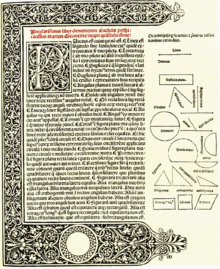Campanus of Novara
Campanus von Novara , Latinized Campanus Nouariensis, also Campano da Novara, Giovanni Campano (later sometimes Johannes Campanus), (* around 1220 probably in Novara ; † 1296 in Viterbo ) was an Italian astronomer, mathematician, astrologer and doctor.
He was the local chaplain of Popes Urban IV , Hadrian V , Nicholas IV , Boniface VIII and died relatively wealthy. He knew Urban IV before his time as Pope (from 1261) when he was still the Patriarch of Jerusalem. Urban IV not only made him his chaplain, but also procured him various benefices (Rector of the Church of Savine in the Diocese of Arles 1263, Canon of the Cathedral of Toledo 1264). Hadrian V (Ottobono Fieschi) also patronized him when he was papal legate in England from 1255 to 1268 and even before he became pope in 1276. He made him his chaplain in 1263/64 and procured him a benefice in Felmersham in Bedfordshire. Later a canonical was added in Paris. But there is no evidence that he was ever outside of Italy. Most recently he lived in the Augustinian convent in Viterbo, where he oversaw the construction of a chapel dedicated to Saint Anne in the Church of the Holy Trinity. The date of death is documented in a letter from Boniface VIII dated September 17, 1296.
In a 1531 edition of Euclid he is described as a master's degree, but there is no evidence that he taught at a university.
Roger Bacon in England named him in 1267 one of the four most important living mathematicians (although he did not count him among the two perfect ). There is no evidence that they knew each other. Most likely, Bacon knew Hadrian V when he was a legate in England.
He wrote a Latin edition of Euclid's Elements in fifteen books (1255 to 1259), which was the most widespread edition until the 16th century and was also the first printed Latin edition ( Erhard Ratdolt , Venice 1482). It was based on preliminary work by Adelard von Bath (Latin Euclid translation), Robert von Chester (Latin translation of Euclid's Commentaries), the elements of arithmetic by Jordanus Nemorarius and was also provided with its own additions. He quotes various Arabic mathematicians (often in Latin translation by Gerhard von Cremona )
In astronomy he wrote the Theorica Planetarum (1261-1264, Urban IV. Dedicated) on planetary motion and the construction of an equatorium to represent it. The work is based next to the Almagest by Claudius Ptolemy (probably in the translation by Gerhard von Cremona), on the Toledaner Tafeln (Toledo, 1080) and the writings of the Arab astronomer Arzachel . After Toomer, it was the first detailed account of the Ptolemaic system in the Latin-speaking West. The design of his equatorium was not very practical; a later design by Petrus de Dacia was more sustainable . The manuscript was never printed, but a large number of manuscripts have survived and were influential. In this work he also tries to derive the distances and dimensions of the planets, which goes beyond Ptolemy (who only gives the absolute distances for the sun and moon).
Further astronomical writings are Tractatus de sphaera (an elementary astronomy book, after 1268) and Computus maior for the calendar calculation including the date of Easter (1268), both printed up to the 16th century, a description of the astrolabe and De quadrante (about the use of the quadrant ). Two mathematical writings based on Thabit Ibn Qurra are probably from him ( De figura sectore , De proportione ). Other attributions are uncertain.
Campanus also had a reputation as an astrologer, which he probably also used in addition to his medical knowledge for his career with high church princes. The division of the zodiac into twelve houses was ascribed to him ( Regiomontanus ), but is older. He also had his astrological knowledge from the Arab world ( Abraham ibn Esra ). No astrological manuscripts have come down to us from Campanus himself.
The lunar crater Campanus is named after him.
literature
- Gerald J. Toomer Campanus of Novara . In: Dictionary of Scientific Biography
- Francis Seymour Benjamin, Gerald J. Toomer: Campanus of Novara and medieval planetary theory: Theorica planetarum . University of Wisconsin Press 1971 (critical edition)
- Hubert LL Busard : Campanus of Novara and Euclid's Elements . Stuttgart, Franz Steiner Verlag 2005
- Hubert LL Busard, KA Tredwell: Campanus de Novara . In: Thomas F. Glick, Steven J. Livesey, Faith Wallis (eds.): Medieval science, technology and medicine: an encyclopedia . Routledge 2005
- Noel Swerdlow : The planetary theory of Campanus . In: Journal for the history of astronomy , Volume 4, 1973, pp. 55-61
Web links
- John J. O'Connor, Edmund F. Robertson : Campanus of Novara. In: MacTutor History of Mathematics archive .
Individual evidence
- ^ Toomer, Dictionary of Scientific Biography. The manuscript refers to Urban IV (Jacques Pantaléon) when he was still Patriarch of Jerusalem (1255–1261).
- ^ Toomer, Dictionary of Scientific Biography. Because of Widmund to the Pope. It should not be confused with a series of manuscripts of the same name by an anonymous author from the 13th century.
- ↑ The dating is based on the fact that he quotes the Computus. Similar works were written by Robert Grosseteste , Sacrobosco
- ↑ Dating based on a calculation in the manuscript
- ^ Computus first in Venice 1518, the Sphaera also in Venice 1518
| personal data | |
|---|---|
| SURNAME | Campanus of Novara |
| ALTERNATIVE NAMES | Campanus nouariensis; Campano da Novara; Giovanni Campano; Johannes Campanus |
| BRIEF DESCRIPTION | Italian clergyman, mathematician, doctor, astrologer and astronomer |
| DATE OF BIRTH | around 1220 |
| PLACE OF BIRTH | Novara |
| DATE OF DEATH | 1296 |
| Place of death | Viterbo |

